The Colombian shoemaker turning the Italian footwear industry on its head
Born in Cartagena and raised in Barranquilla, Edgardo Osorio is one of Nicole Kidman and Julianne Moore’s favorite designers. His goal is to make over $100 million in sales in 2025, without compromising his creative independence
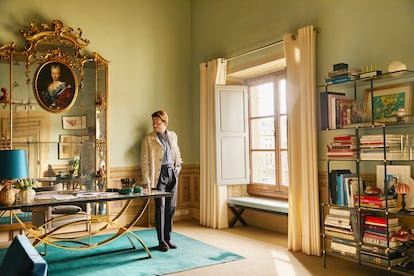
Edgardo Osorio, 37, knows how to say no. And he’ll say it as often as he needs to, but always with a wide smile of straight, extremely white teeth. He only does what he feels like doing, and he does it from the halls of the Corsini Palace in Florence, Italy, where he’s lived and worked since 2014. Fifteen years ago, he didn’t live in a beautiful Quattrocento palazzo, and barely spoke any Italian, but he had the same smile, good contacts, and that special something called charm, which he calls “just being friendly.” “In Italy, a smile goes a long way,” he admits. Osorio founded Aquazzura in 2012, a brand that today brings in annual revenues of around €70 million. He got his start creating luxury sandals with 4-inch heels that promised the impossible: you could dance in them all night long.
Osorio also likes to dance all night long. “I dance with my soul, with my heart, and I have no idea if I’m doing it right or wrong,” he says. He was born in Cartagena de Indias, Colombia, and then immediately moved to Barranquilla. As he grew older, he started to notice that at the weddings he attended, the dancers all had the same problem: their shoes — “all very expensive” — would force them to stop dancing. He says this happened at up to 12 weddings during one summer. And then it hit him: this was a business opportunity. The epiphany struck him when he was on Capri, an island in Italy’s bright-blue Bay of Naples. In Italian, aquazzura means “blue water.”
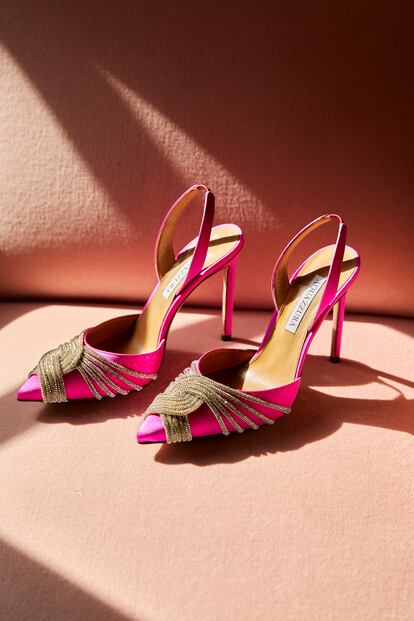
Osorio grew up surrounded by women: his mother, his four aunts, and their female friends. “As a child, I saw shoes everywhere, and learned to understand the feminine point of view,” he says. He was going to be a doctor. With any luck, he would become a plastic surgeon, the only medical specialty he thought of as creative. It was a smart solution to finding a balance between his artistic drive and the financial pragmatism of his father, a businessman in construction. But at the age of 14, a plot twist took Osorio to England for a summer course at Central Saint Martins, an art and fashion school in London. At 16, after graduating from high school, he returned to the country to study Accessories at the London College of Fashion, a degree he never finished. “I came to London and my eyes were opened wide, but I wasn’t prepared for the weather,” admits the designed, who says he’s a “sunseeker.” Osorio chases the summer all year long, even if it means changing hemispheres every six months.
At 19, he moved to Florence to start a consulting firm for brands like Ferragamo and René Caovilla, and soon got a job as creative director of footwear at Roberto Cavalli. At 25, he partnered with a craftsman experienced in foot anatomy and founded Aquazzura. I asked him how he managed to be accepted into a conservative, tight-knit and traditional industry like the Italian shoe industry. “First of all, I would never tell anyone my age, so that they would take me seriously,” he says. “I was always surprised that there was no new creative force in my generation — it was all people 30 or 40 years older than me. Florence hadn’t opened a new fashion house in many years. Ferragamo had more than 100; Gucci, more than 90; Cavalli, 60.” Osorio convinced the manufacturers to help him. “I already spoke Italian, and I had worked with them... In Italy, a smile gets you a long way, and I didn’t have any money... Just a lot of smiles and a lot of favors.”

In 2012, to talk about a comfortable stiletto was sacrilege. The world was still a few years away from high-end sneakers dominating the market and Armani suits with tennis shoes appearing on the red carpet. But Aquazzura sandals, which were lightweight, with a design that distributes body weight between the sole, arch and heel, and viscoelastic cushioning, broke the spell. Osorio interlaces his fingers and wraps his hands around his foot: “The shoe has to fit like this, like a glove. I literally cut it around the foot, then I fix it and modify it. It has to be an extension of the body. When you try on a shoe that has something weird to it and it doesn’t quite work — which is something I experience quite a lot, because I like to go shopping with my friends — it’s because it’s not designed to be worn, but to be an object in a shop window.”
Osorio says at first, his shoes sold by word of mouth. Giovanna Battaglia, a creative director at Swarovski and Osorio’s personal friend, was the first to be photographed on the street wearing Aquazzura. Instagram and street style were just being born. “Suddenly I started seeing my shoes on the street — like, a lot. I remember during a fashion week in Milan, in the front row, everyone was wearing my sandals,” Osorio recalls. In his office, one whole wall is covered with photos and handwritten thank-you notes signed by Sienna Miller, Julianne Moore, Nicole Kidman and Olivia Palermo. His sandals have been worn by Lady Gaga in House of Gucci, Ana de Armas in No Time to Die and Sarah Jessica Parker in And Just Like That…, the sequel to Sex and the City, the show that launched Manolo Blahnik designer sandals in the early 2000s.
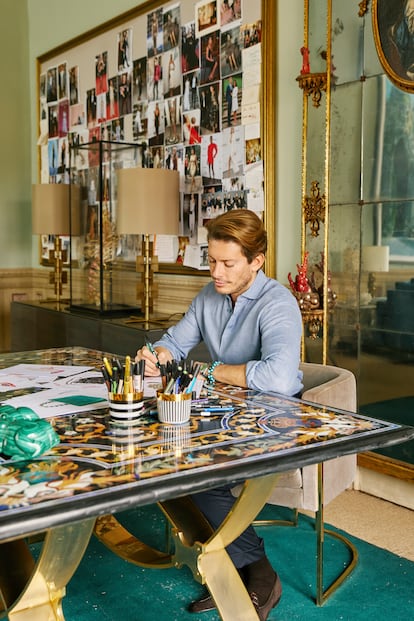
“Every year, I think, my God, this is a miracle!” Osorio tells me as he fixes his eyes on one of the 18th-century ceiling frescoes that he helped restore. “I always imagined it would be successful, but it’s all happened so fast.” Osorio, together with his partner and right-hand man, Ricardo D’Almeida, inhabit the former quarters of Maria Maddalena Macchiavelli, wife of Marquis Filippo Corsini, who in 1649 bought the palazzo from the Medici dynasty. They turned the top floor into their home, and the floor below into their offices. They share the palazzo with the owners, Lucrezia Corsini and Livia Sanminiatelli. From their windows, you can see the Arno River and the Ponte Vecchio. Inside, the room is eclectic and colorful. Bronze statues, trompe-l’oeil doors and furniture from the 18th century coexist with red coral, photos of Peter Beard, paintings by Julian Schnabel and his daughter Lola, and hundreds of magazines that have taken over the shelves and side tables.
At the last Paris Fashion Week, Aquazzura presented its first collection of leather handbags at a massive party. Osorio explains his concept as being the opposite of what you find on the market: basic bags, all identical, distinguished only by a huge logo. “My bags, like my shoes, will have a lot of soul but no logo,” he says.
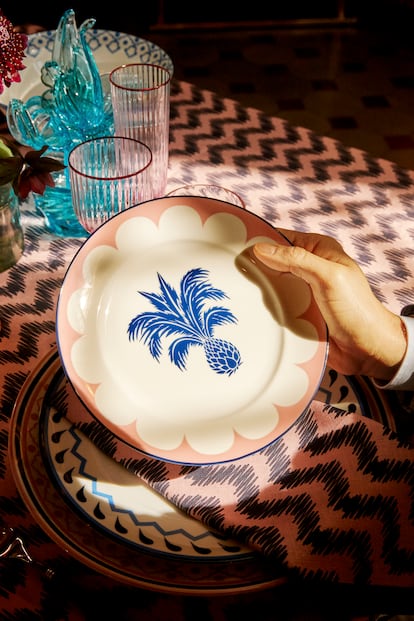
By 2021, Osorio was exploring new terrain, launching a line of fashion jewelry and a home collection featuring tableware, tea sets, Murano glassware and embroidered table linens. His next goal is to manufacture men’s shoes and make inroads in the world of fragrances and sunglasses. His plans for expansion are ambitious. By 2025, he wants to bring in over $100 million, while maintaining his brand independence. “Here, I can do what I want because Aquazzura is mine,” he says. His hope is to make Aquazzura a lifestyle brand, a way of living. Osorio has just opened two stores Madrid, in the upscale shopping centers Galería Canalejas and El Corte Inglés de Castellana.
“I’m impulsive, that’s why I don’t have Twitter,” explains Osorio, who in 2016 sued Ivanka Trump for copying his “Wild Thing” sandal model, confronting her on Instagram: “One of the most disturbing things in the fashion industry is when someone blatantly steals your copyright designs and doesn’t care. You should know better. Shame on you @ivankatrump! Imitation is NOT the most sincere form of flattery.”
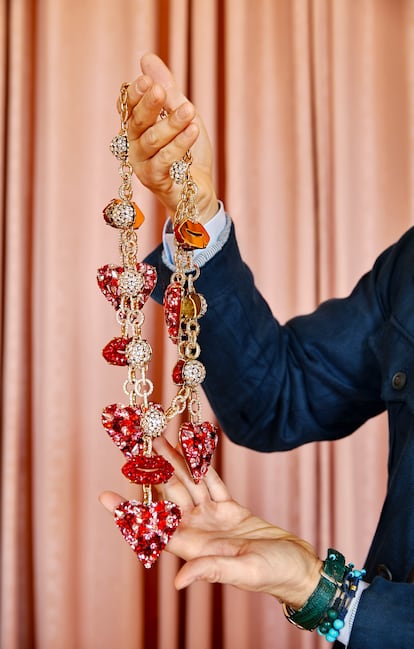
Edgardo Osorio sketches on white cardstock on a mirrored table, choosing from hundreds of different colored markers. On his wrist, he wears an emerald green Rolex and some Nazar bracelets (“I bought them in Mykonos to protect me from the evil eye”). His office is decorated with corals (he collects them), stone turtles, and golden pineapples. Some would say he’s superstitious or, at the very least, that he believes in protecting himself. “I believe in energy,” he tells me discreetly.
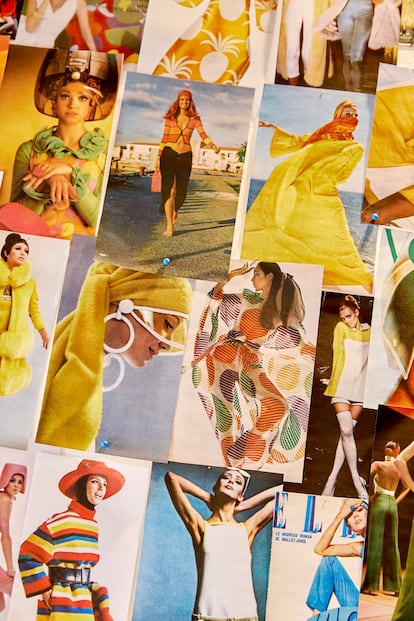
Everything in Osorio’s office has a symbolic meaning and a specific purpose. He had been collecting corals for some time when his vendor mentioned that in Sicily, they were given to brides and grooms as omens of good fortune. The golden pineapple — all of Aquazzura’s shoes have the image of a pineapple, the brand’s logo, on their sole — was placed at the front doors of Italian villas as a sign of hospitality, and to attract good luck. Osorio himself, who has worn several outfits during our interview and photo shoot, without anyone asking him to do so, has changed his shoes every time as well, but always wears the same style: slippers with no socks. It’s a way of fulfilling and demonstrating Aquazzura’s promise: when you find a comfortable shoe, you’ll want to buy it in every color. You have to get off on the right foot, even in a Florentine palazzo.
Sign up for our weekly newsletter to get more English-language news coverage from EL PAÍS USA Edition
Tu suscripción se está usando en otro dispositivo
¿Quieres añadir otro usuario a tu suscripción?
Si continúas leyendo en este dispositivo, no se podrá leer en el otro.
FlechaTu suscripción se está usando en otro dispositivo y solo puedes acceder a EL PAÍS desde un dispositivo a la vez.
Si quieres compartir tu cuenta, cambia tu suscripción a la modalidad Premium, así podrás añadir otro usuario. Cada uno accederá con su propia cuenta de email, lo que os permitirá personalizar vuestra experiencia en EL PAÍS.
¿Tienes una suscripción de empresa? Accede aquí para contratar más cuentas.
En el caso de no saber quién está usando tu cuenta, te recomendamos cambiar tu contraseña aquí.
Si decides continuar compartiendo tu cuenta, este mensaje se mostrará en tu dispositivo y en el de la otra persona que está usando tu cuenta de forma indefinida, afectando a tu experiencia de lectura. Puedes consultar aquí los términos y condiciones de la suscripción digital.
More information
Archived In
Últimas noticias
There is as much life left to discover on planet Earth as that which is already known
Dozens presumed dead, around 100 injured in fire at Swiss Alps bar during New Year’s celebration
Is porn for women different from conventional porn? We spoke to those who make it
Cartagena de Indias is sinking: What can the city do to mitigate it?
Most viewed
- Reinhard Genzel, Nobel laureate in physics: ‘One-minute videos will never give you the truth’
- David King, chemist: ‘There are scientists studying how to cool the planet; nobody should stop these experiments from happening’
- Oona Chaplin: ‘I told James Cameron that I was living in a treehouse and starting a permaculture project with a friend’
- Sinaloa Cartel war is taking its toll on Los Chapitos
- The Interoceanic Train, the Mexican alternative to the Panama Canal











































